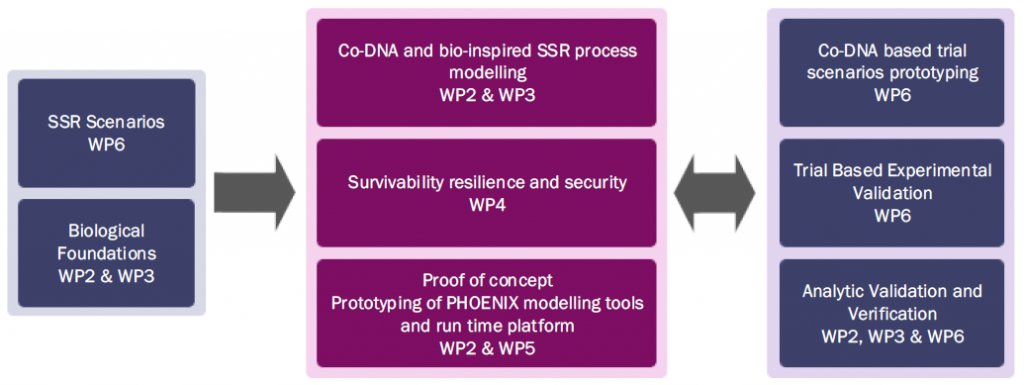The implementation of BIO-PHOENIX will be based on a methodology with three broad phases as shown in the following Figure 1. Based on this approach, BIO-PHOENIX will start by establishing the foundations for developing its approach, through the identification of SSR scenarios and requirements and establishing the bio structures and processes that appear to be relevant to the envisaged approach of BIO-PHOENIX. The latter process will be based on reviewing the biology literature, with the objective of not only identifying and analysing relevant concepts and research but also identifying the abstract features of the relevant bio structures and processes with emphasis on how they enable control in living organisms that supports survivability and repair. The outcomes of the foundation phase will drive the BIO-PHOENIX development phase; SSR scenarios and abstract bio structures and processes will be used to establish their computational counterparts, i.e., to identify how to model co-DNA and bio-inspired SSR processes and develop such models. In the same phase, we will investigate how to address key end-to- end properties of software systems, namely survivability, resilience and security, in the context of the co-DNA based approach. Proof of concept prototyping of tools supporting co-DNA based system modelling and a runtime platform enabling the execution of co-DNA and processes on CCI devices will also be done in this phase.

Development will be followed by validation. This will be based on three methods: (a) validation based on prototyping the system assumed in the SSR scenario using the co-DNA approach that will focus on validating BIO-PHOENIX as a system engineering approach; (b) trial based validation of the co-DNA approach based on controlled experiments using the scenario prototype that will focus on properties of the system SSR process (efficiency, resilience); and (c) formal analysis and verification of further properties and aspects such as computational complexity and security.
The scenarios for trial-based validation will be related to SDN, involving Cloud SDN and Fog SDN, i.e. executing networking operations and applications in a “fog” of network elements such as devices, terminals, cloud infrastructures that are around users, at the edge of the telecommunication networks. The selection of SDN will enable us to explore software system reconstruction (at the SDN control and application layer software) in parallel with the recovery of the physical network infrastructure (although the latter will not be controlled by co-DNA approach). For Cloud SDN evaluation BIO-PHOENIX will use SmartFIRE (eukoreafire. eu/), a large-scale experimental facility, enabling SDN experimentation and distributed applications. For Fog SDN evaluation our plan is to use the REDComm infrastructure (redcomm-project.eu), a rapid
deployment infrastructure developed to form wireless networks to support communications in emergencies, in cases where standard communication networks are not available.
The outcomes of the validation activity will feed back into (another cycle of) the BIO-PHOENIX development phase, in order to address critical outstanding issues and produce an advanced version of the BIO-PHOENIX runtime platform.
